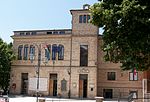Abbey of Santa Maria in Montesanto
13th-century Roman Catholic church buildings in ItalyBenedictine monasteries in ItalyChurches in the province of TeramoRomanesque architecture in Abruzzo

The Abbey of Montesanto or Abbazia di Santa Maria in Montesanto is Romanesque-style Benedictine monastery located in the rural hills outside the town of Civitella del Tronto, in the province of Teramo, Abruzzo, Italy.
Excerpt from the Wikipedia article Abbey of Santa Maria in Montesanto (License: CC BY-SA 3.0, Authors, Images).Abbey of Santa Maria in Montesanto
Strada Provinciale 14 di Santa Reparata, Unione dei Comuni della Val Vibrata
Geographical coordinates (GPS) Address Nearby Places Show on map
Geographical coordinates (GPS)
| Latitude | Longitude |
|---|---|
| N 42.787 ° | E 13.6542 ° |
Address
Abbazia di Santa Maria in Montesanto
Strada Provinciale 14 di Santa Reparata
63084 Unione dei Comuni della Val Vibrata
Abruzzo, Italy
Open on Google Maps






